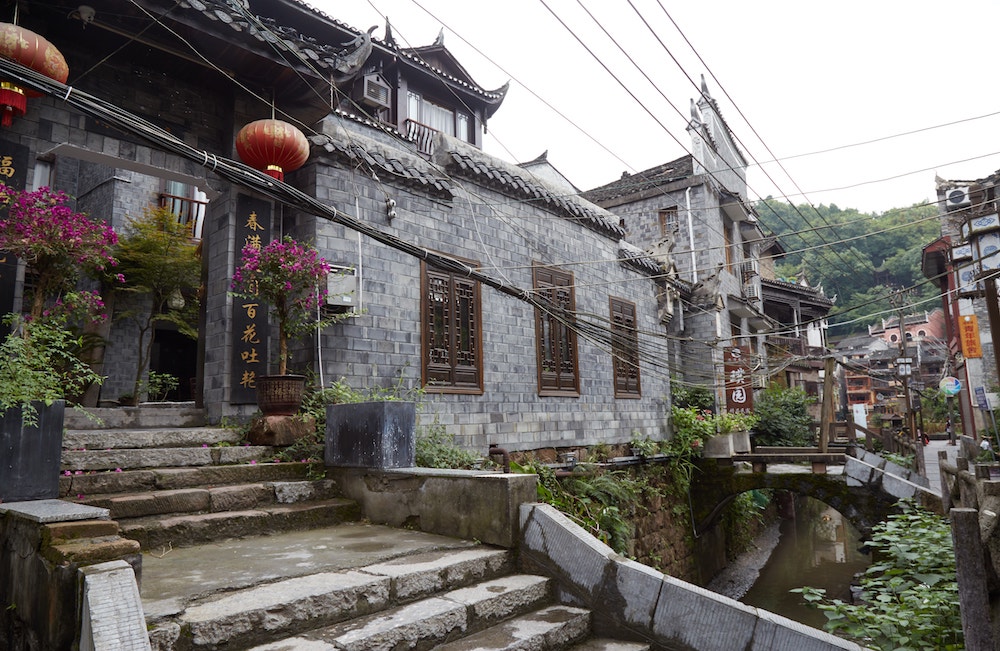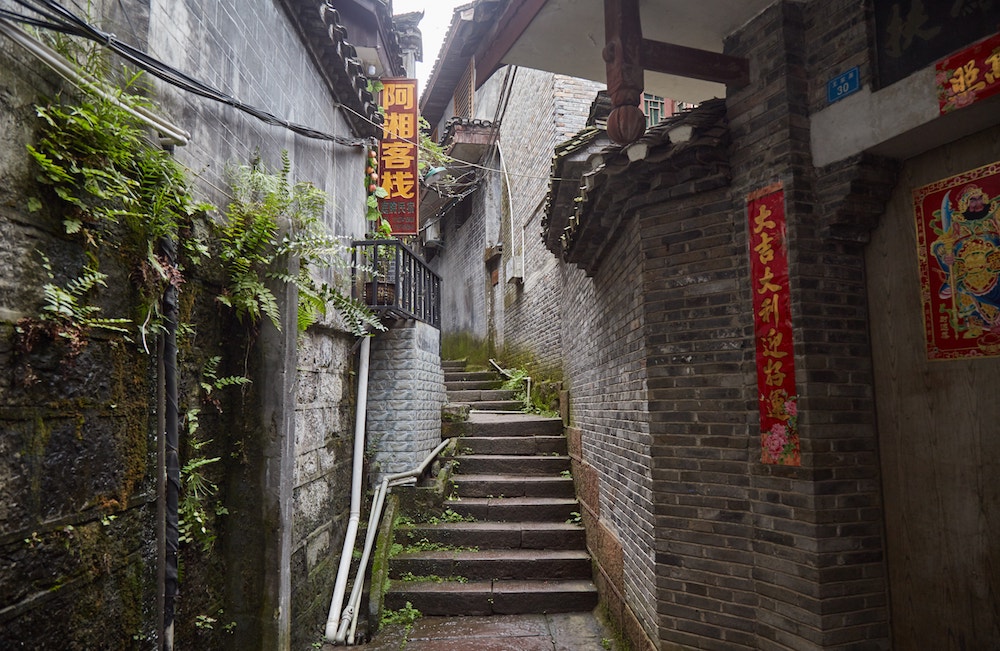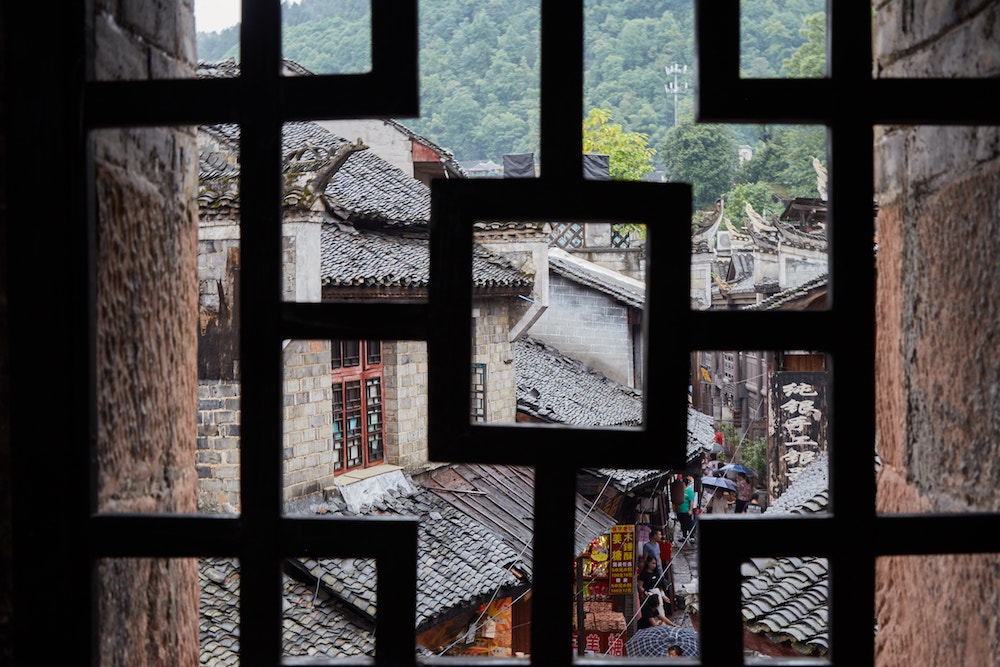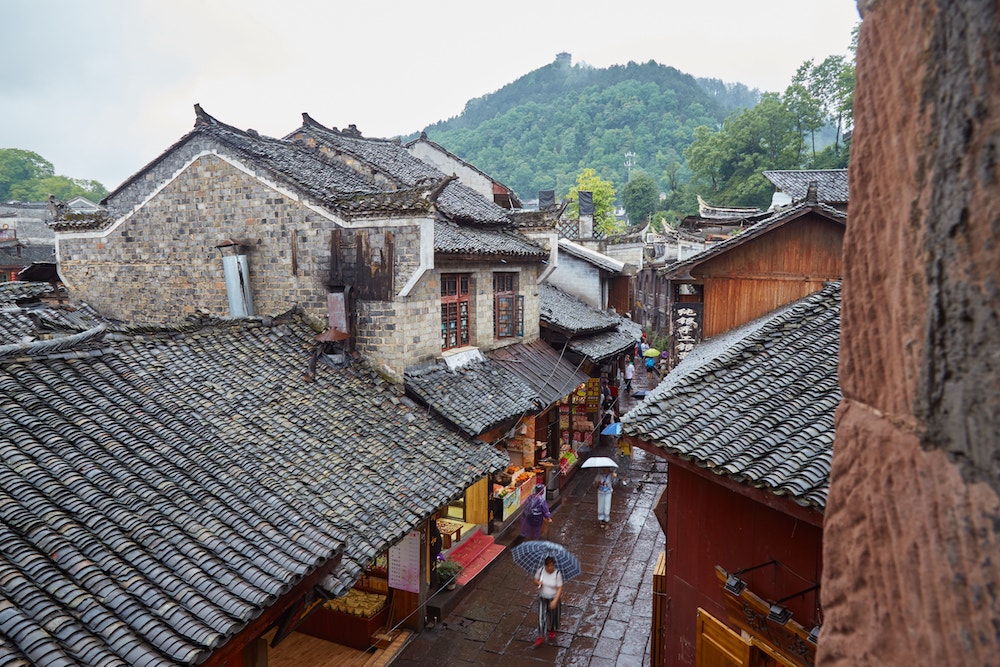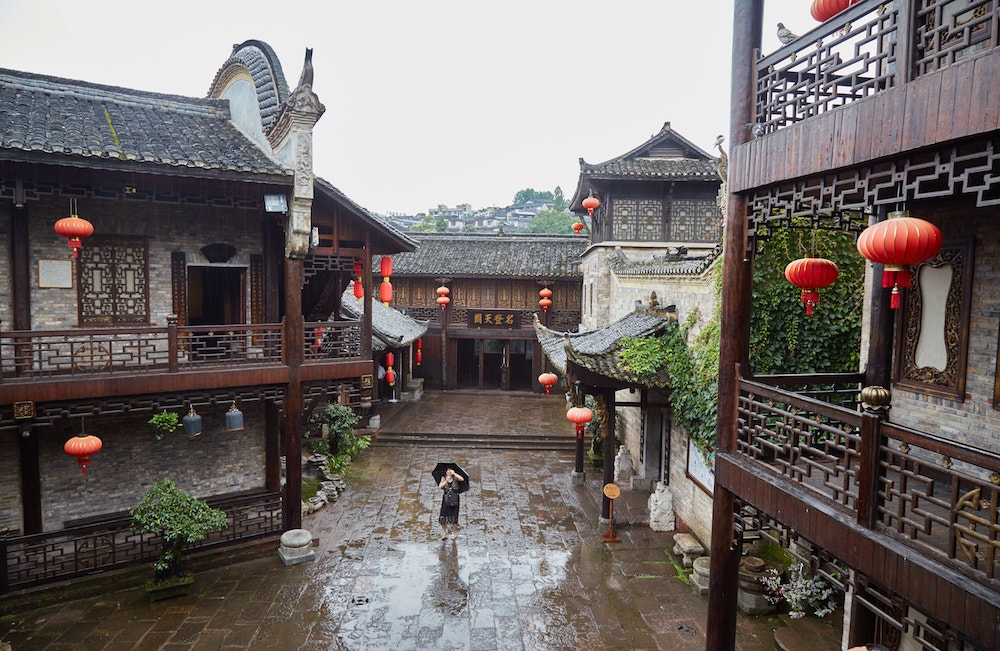Last Updated on: 3rd December 2019, 08:29 pm
It would be hard to look at pictures of Hunan Province’s Fenghuang Ancient Town and not feel drawn to the place. Its stilt houses, picturesque river area and cobblestone alleyways combine to make it one of China’s most scenic towns. But while domestic tourists flock to Fenghuang in droves, it remains well off the radar for most foreign travelers.
In English, Fenghuang translates to ‘Phoenix.’ Supposedly, the town got its name because one of the nearby mountains resembles the mythical bird. But the Phoenix was also one of the main objects of worship of the Chu people, an ancient kingdom that ruled here thousands of years ago. Be that as it may, Fenghuang Ancient town wasn’t founded until the 16th century.
And it developed quickly. During the early part of the Qing dynasty (1636 – 1912) it became the most prominent town of western Hunan. A plethora of skilled craftsmen moved in and it turned into a major trading center. Many of Fenghang Ancient Town’s landmarks, in fact, date back to this period.
Another element that makes Fenghuang unique is its ethnic makeup. Most local residents, both historically and in the present, belong to either the Miao or Tujia ethnic groups. As such, the local architecture, like Fenghuang’s iconic stilt houses, are unique within China.


And for better or for worse, Fenghuang Ancient Town has received a number of modern additions as well. Every night, for example, the town’s buildings are illuminated, creating a mesmerizing – if not somewhat artificial – spectacle. And to the dismay of many, Fenghuang turns into a loud and raucous party destination after dark, despite appearing so quaint and traditional in photographs.
This is enough to turn some people off from visiting altogether, and understandably so. But if you visit Fenghuang with realistic expectations, there are more than enough positives to outweigh the negative aspects.
In the following Fenghuang Ancient Town guide, we’ll be covering the best things – whether free or paid – that you can see and do over the course of a few days.
Note: Google is banned in China. To see this map during your trip, you’ll need to use a VPN. Learn more at the end of the article.
Fenghuang's Ticketing System
There seems to be some conflicting information online in regards to how much it costs to enter Fenghuang and see the sites around town. At the time of writing, access to the town is free. Years ago, visitors needed to pay just to access the Ancient Town area itself, as is common at other Ancient Towns around China. Supposedly, as one local explained to me, tourism declined so much that they had to nix the system.
Now the town itself is free to enter. There is, however, a special ‘through ticket’ you can buy which gives you access to a number of attractions. For ¥168, not only can you see the sites within the Ancient Town itself, but it also includes the Southern Great Wall, roughly 15km west of town. You can learn more about each attraction down below.
But is the ticket worth it? Honestly, there’s no single attraction included in the ticket that’s going to blow you away. And Fenghuang’s most impressive scenery, such as its stilt houses and riverside promenade, are completely free.
But if you’re spending more than a day in town, you should consider buying one. It gives you something to do, and by searching for all the sites, you may end up discovering brand new parts of Fenghuang that you wouldn’t have known about otherwise.
Note that some people have reported being asked for proof of a ticket while just walking around town. As that system is no longer in place, anybody asking you to present a ticket at random is surely a scammer and should be ignored.
Note that rather than a physical ticket, you may just be given a special number which you’re supposed to present at each attraction instead. Strangely, there are lots of staff members around town still unfamiliar with this new digital system. If they turn you away at first, keep insisting, and their manager will eventually come over to let you in.
Along the River
The heart of Fenghuang Ancient Town is its riverside. The town is situated along the Tuo Jiang River, which is where you’ll find its most impressive bridges and iconic stilt houses. While certain areas of the river can get crowded, it’s not too difficult to find quieter areas, especially in the southeastern area. And taking a short boat ride along the river is another one of Fenghuang’s most popular activities.
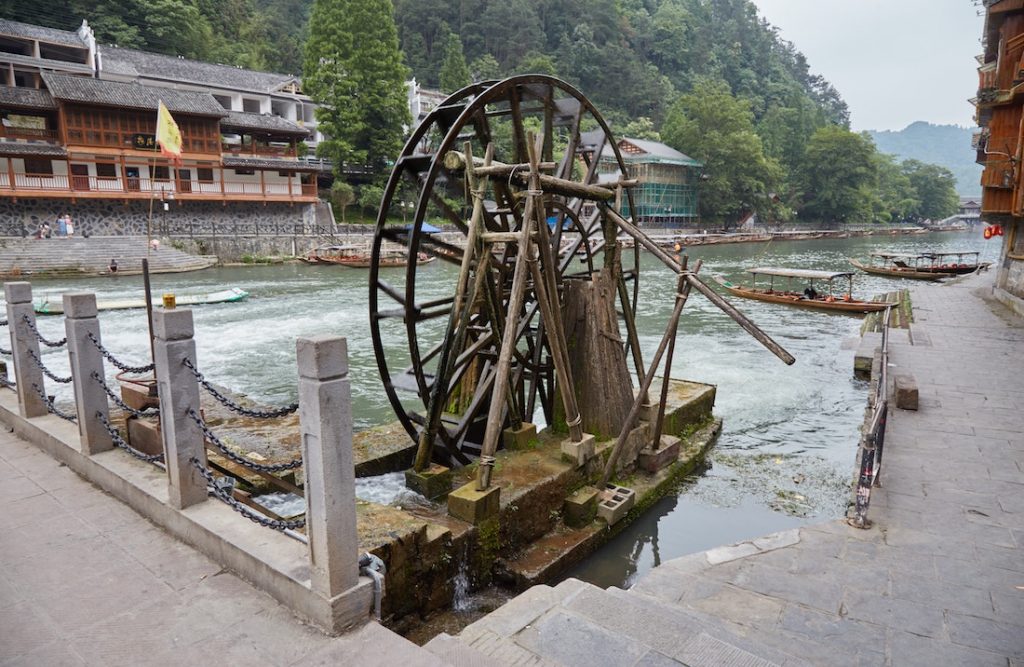
Stilt Houses
Fenghuang’s stilt houses, one of the town’s most prominent features, are locally referred to as Diaojiaolou. These types of houses are common, in fact, in both Tujia and Miao towns and villages.
According to legend, Diaojiaolou houses were first invented as a way to protect families from venomous snakes and scorpions. But as seen in Fenghuang and nearby Furong, the stilts come in handy to prevent flooding as well.
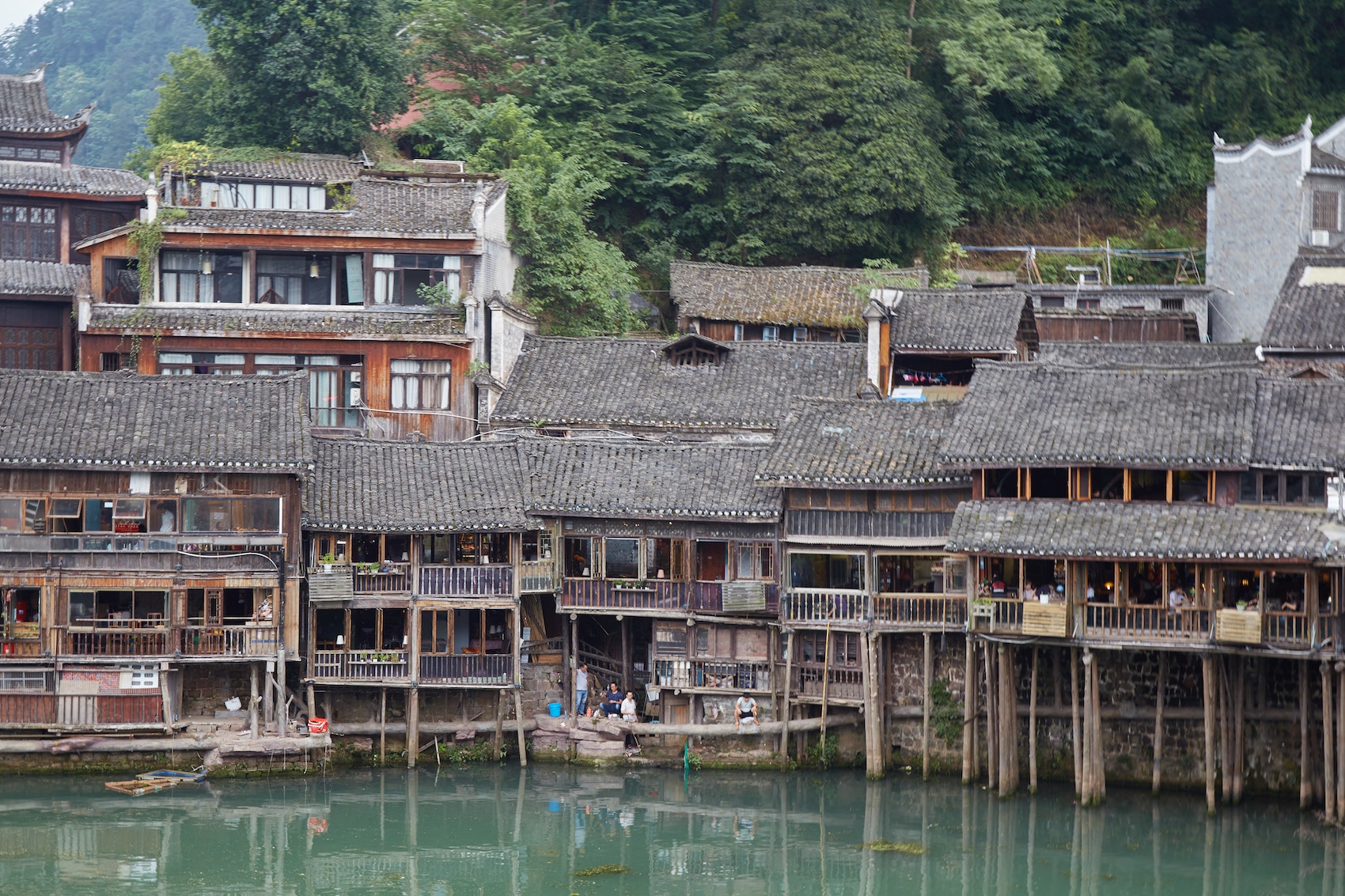
The stilts are also said to have symbolic significance, with the long vertical poles representing the link between heaven and earth. And considering how many Diaojiaolou buildings don’t even use any nails, it’s quite remarkable that they’ve managed to survive intact for centuries.
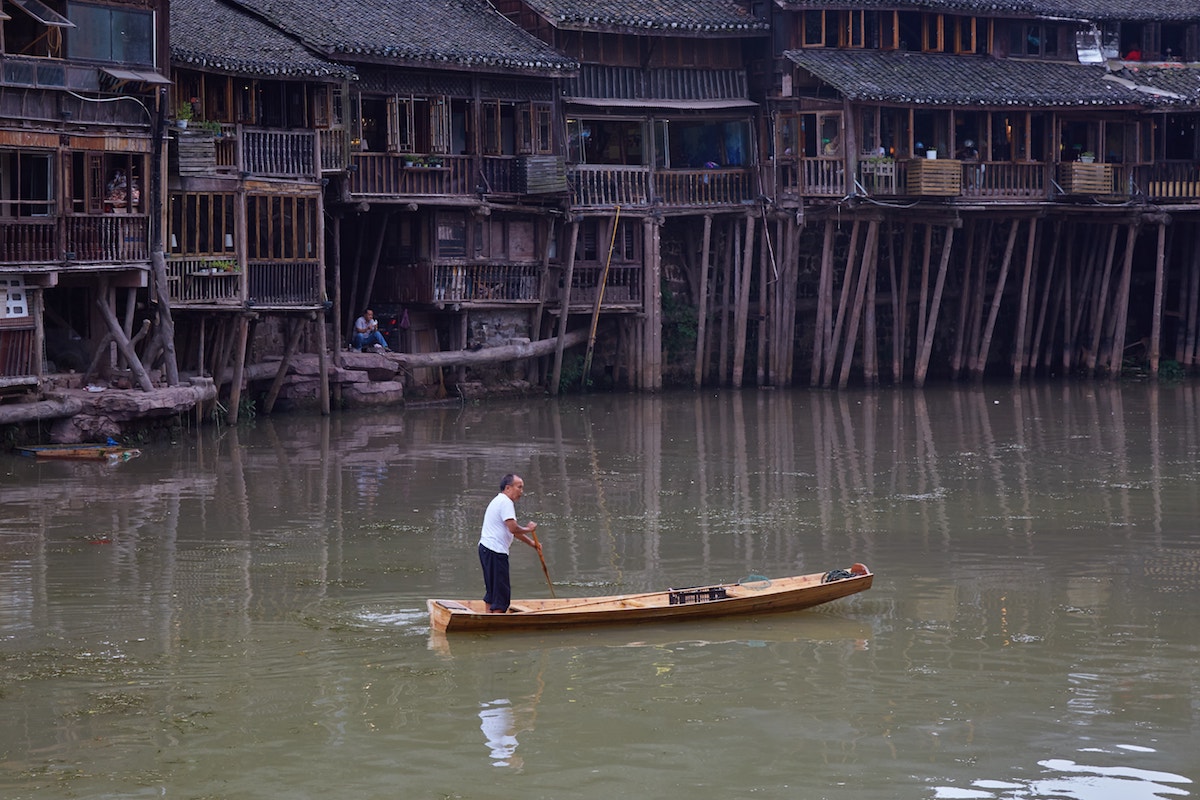



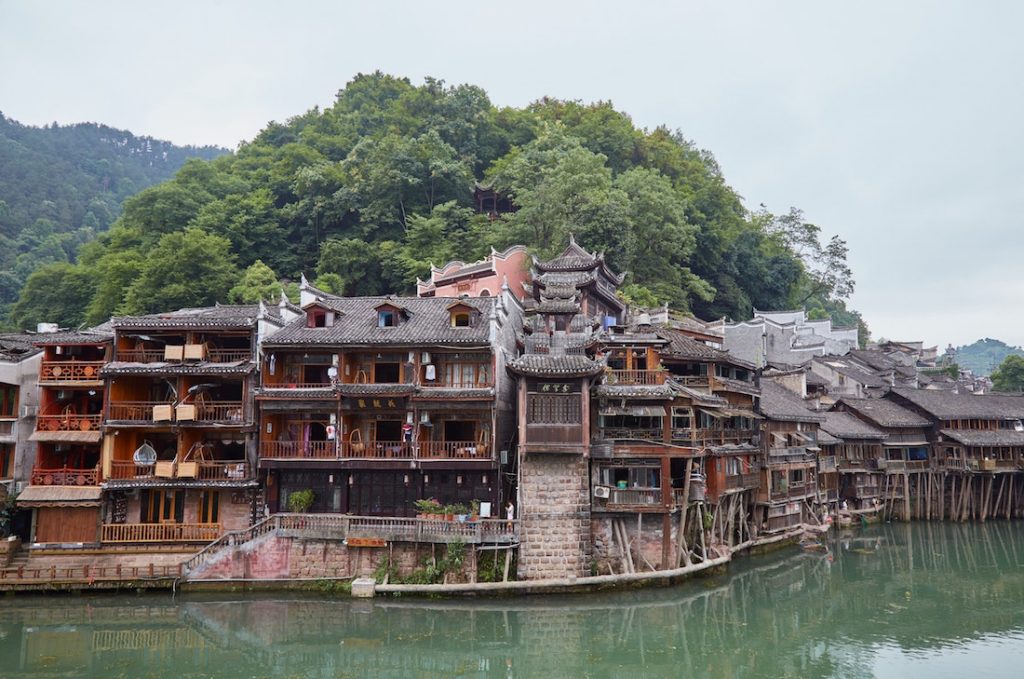

The Rainbow Bridge

Though there are a number of bridges along the Tuo Jiang River, the Rainbow Bridge is the Ancient Town area’s largest. And along with the stilt houses, it’s become a symbol of Fenghuang itself. Also known as the Hongqiao Bridge, it was first built during the Ming dynasty and then reconstructed in 1670. it’s easily recognizable from afar for its large brick base consisting of three wide arches.
Another nickname for the bridge is the ‘Covered Bridge.’ Walking across it, you’ll encounter a crowded marketplace featuring dozens of small shops on either side. The bridge is situated in between the central part of the Ancient Town on one side, and bustling Hongqiao Road on the other.




Note that there is supposed to be an attraction on the second floor of the bridge which is normally included in the Ancient Town tickets. While I found the steps to get up there and discovered a spacious room, a worker immediately signaled for me to leave. It was either under renovation during my visit, or it may have been shut down for good.
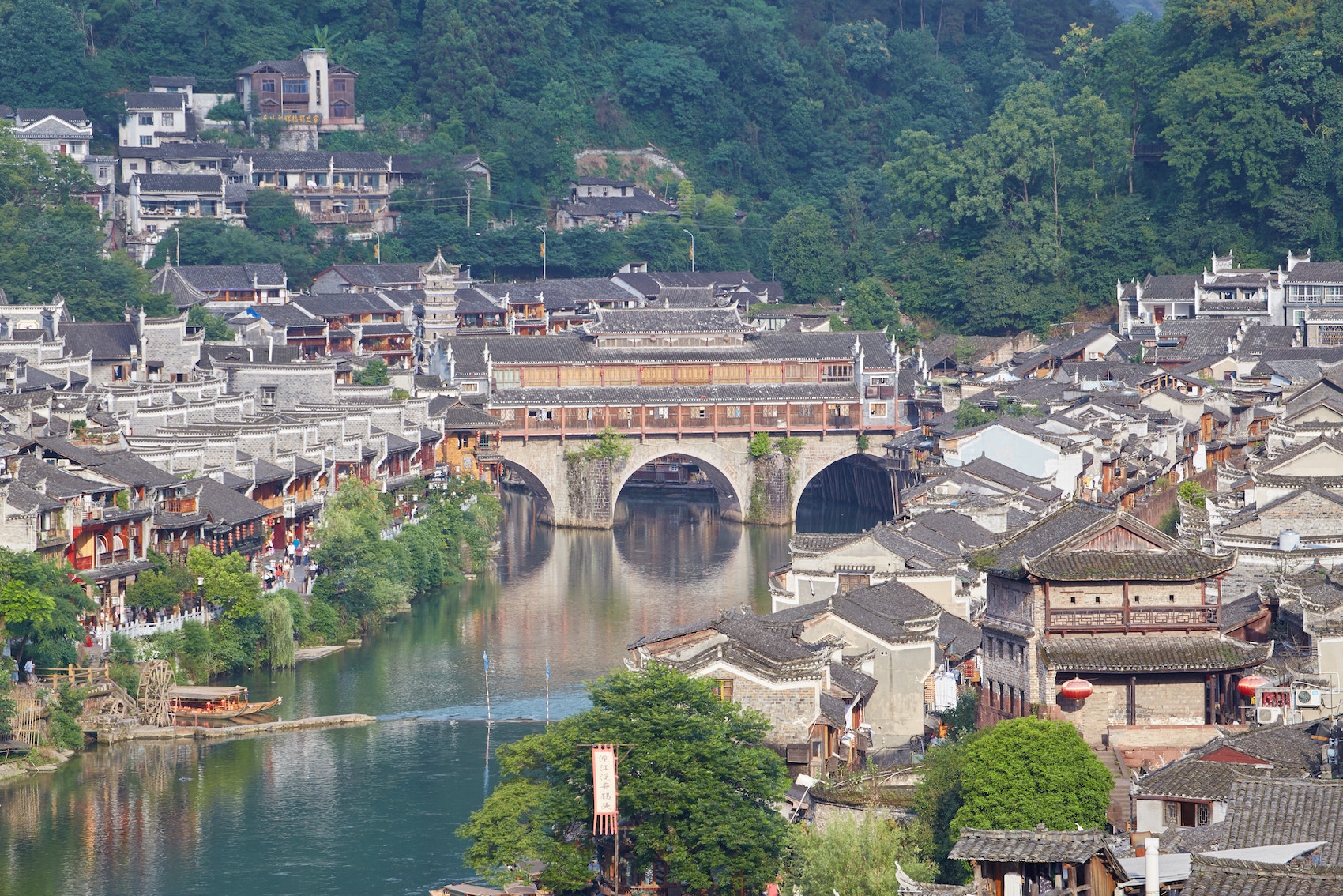
Wanming Pagoda
Another famous riverside landmark is the Wanming Pagoda, first built during the Qing dynasty. Supposedly, it was constructed on the spot where locals used to burn their paper waste.
The narrow pagoda cannot be entered. Be sure to come back at night, though, to see it beautifully illuminated (pictures down below).




The Boat Ride
One of the main activities to experience in Fenghuang is a boat ride along the river. Note that there are boatmen all along the Tuo Jiang who will try and get you to haggle for a price. If you bought the Ancient Town ‘through ticket,’ however, a boat ride is included. But you can only board at the wharf near the North Gate.
The ride is relatively short, lasting around ten minutes or so. While you won’t get to see anything that you couldn’t by just walking along the river, it does make for a fun little trip that’s worth doing at least once.





Various Other Bridges

While the Hongqiao Bridge is the most famous, there are plenty of other bridges to take you back and forth across the river. Some of the larger ones near the southeastern section of the river contain their own lookout pavilions. But aside from Hongqiao, the two most popular bridges with tourists are also the most barebones.

You’ll find two small parallel bridges close to the North Gate area – one of them consisting of small concrete steps, and the other just a long wooden plank. While not especially difficult to cross, you might want to avoid them when they’re too crowded. Though I didn’t see anyone fall in the river, it really wouldn’t have shocked me if I had!
The slight risk is worth it, as the view from the center is one of the most photogenic angles you can get of Fenghuang Ancient Town.

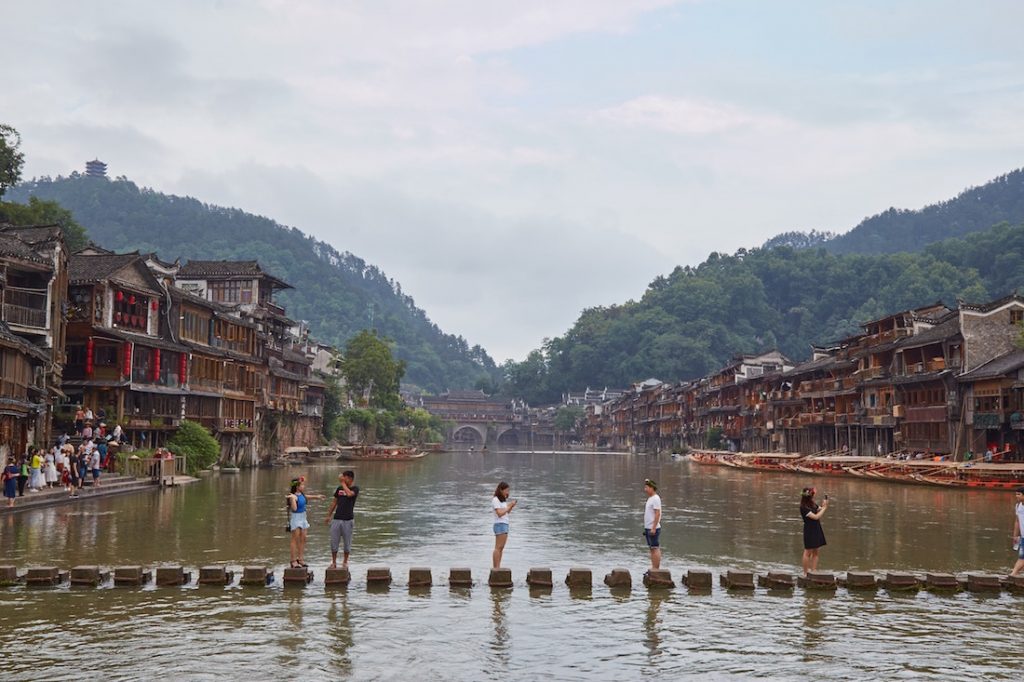

Exploring Fenghuang's Backstreets
One of the best thing about Fenghuang Ancient Town is the fact that it’s pedestrian only. That’s right – no need to constantly look over your shoulder for motorbikes zooming down the sidewalk. And while certain areas can get crowded, most of Fenghuang is a pleasure to traverse on foot.
In total, the Ancient Town district has dozens of cobblestone streets and alleyways. During your stay, be sure to devote some time to wander aimlessly and explore as much as possible.




Given the layout of the town, however, it can take awhile to figure out where things are. For those staying near the South Gate, your most helpful landmark is probably going to be Phoenix Square (locally known as Congwen Square – pictured above). That leads right into the Dongzheng Shopping Street, where attractions like the Gucheng Museum are located.
But as mentioned, don’t worry too much about getting lost – that’s half of the fun!


In addition to the hotels and souvenir shops targeted at tourists, you’ll also come across lookout pavilions, small hole-in-the-wall restaurants and ancient temples. Go slowly and take in the numerous details, such as the old tiled roofs or the Phoenix imagery on display all throughout the city.


As touristy as Fenghuang is, a fair amount of local residents, do, in fact, still live here. Heading down some of the quieter backstreets can offer you a little taste of local life. One can’t help but wonder, though, how local residents must feel about the transformation of their town in recent years.


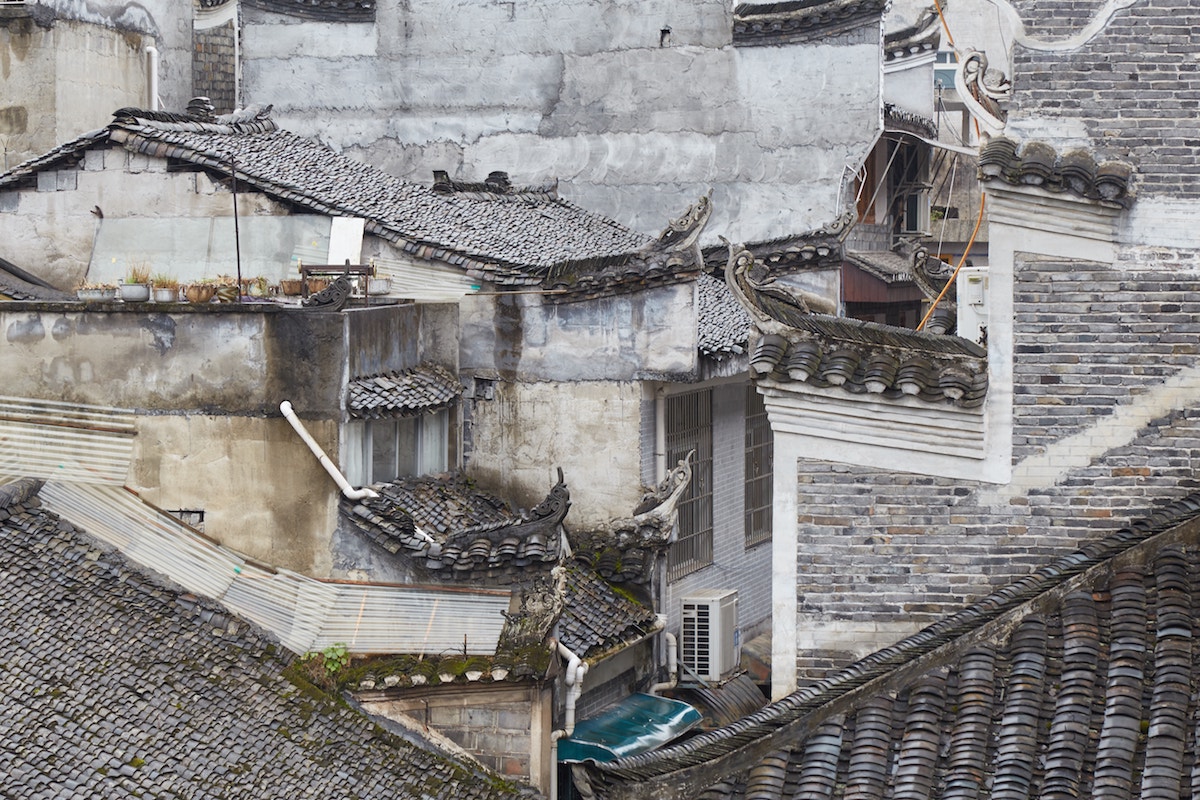

There are a number of ways to escape the crowds. One would be to head over Nanhua Gate in the town’s west. There, you’ll find a hilltop area with a pavilion and an old city wall (possibly a 1980’s remake, though). And you can also get excellent views of the town down below.
For photographers, the nearby Fenghuang Bridge also provides some clear vantage points of the river.



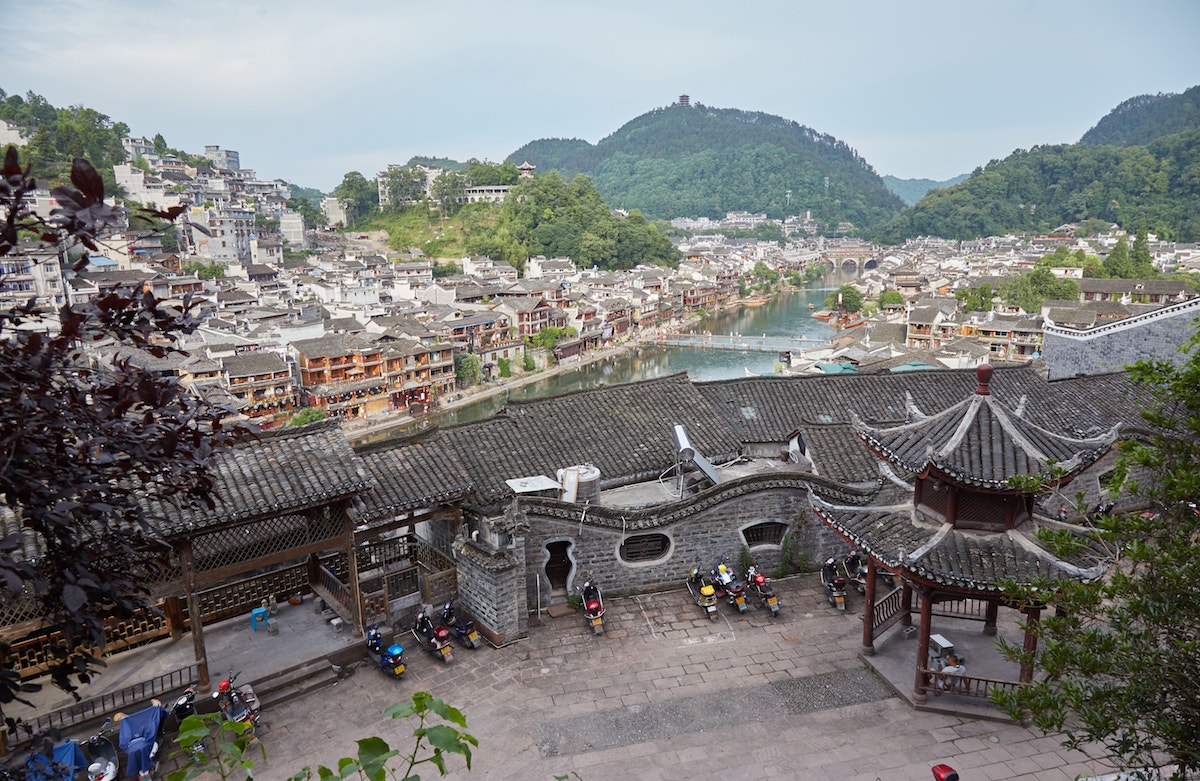
While most of the main landmarks can be explored in just a day or two, I continually came across more and more streets that I hadn’t walked down before as time went on. It’s also worth going out and exploring Fenghuang in the rain, when some parts of town might become shrouded in mist.
Fenghuang Ancient Town Attractions
The following attractions are all included in the Fenghuang Ancient Town ‘through ticket’ mentioned at the beginning of the article. The ticket also includes a boat ride and access to a gallery above the Rainbow Bridge. However, as mentioned above, the bridge gallery was inaccessible during my visit.
East Gate Tower
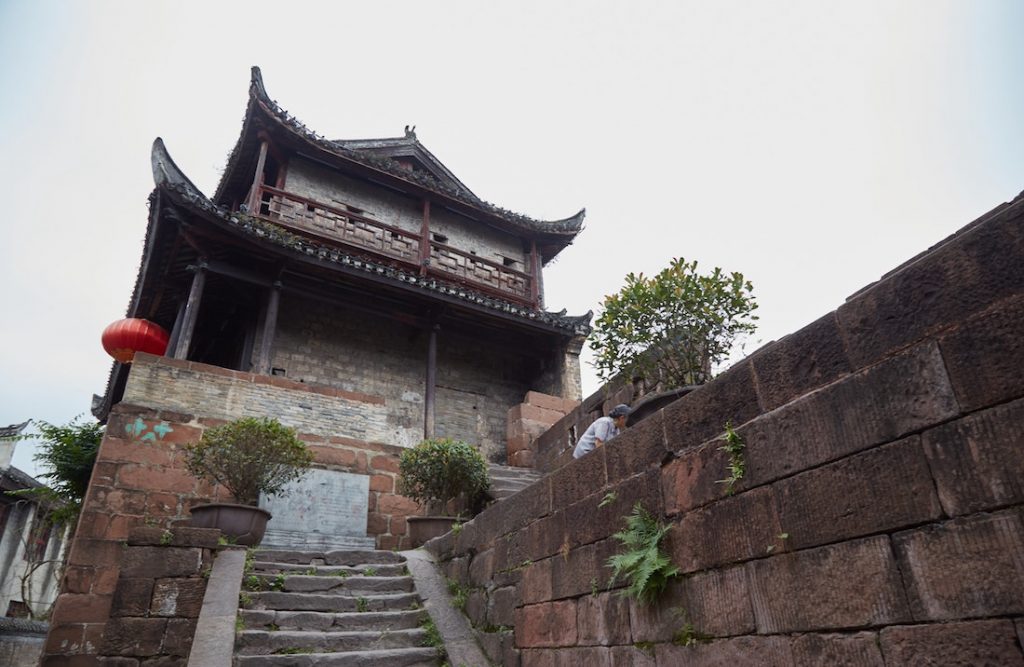
The East Gate Tower is one of four original towers in Fenghuang Ancient Town. Built in 1715 during the Qing dynasty, the tower’s interior contains a collection of ancient cannons.
But even if you haven’t purchased the through ticket, you can at least walk around outside. On one side, the gate and wall provide excellent views of the Tuo Jiang River. And in the opposite direction, you’ll get a great vantage point of some of the town’s charming alleyways.
Gucheng Museum

Also simply known as the Fenghuang Ancient Town Museum, you can find it on Dongzheng Shopping Street, not too far from Phoenix Square. As one might expect, the museum contains all sorts of precious artifacts and relics from the town’s past. Unfortunately for foreign visitors, though, the total lack of English signage makes it impossible to tell what’s what.
The two-story museum is situated in an ancient house. And even with the lack of information, the structure is very interesting to walk around. Even some of the bedrooms of its former inhabitants have been kept in place.
Yang Ancestral Hall

Ancestral halls have long been important in China as a way to bring certain clans and communities together. Not only have they acted as shrines for ancestor worship, but also as places to hold important community meetings.
The local Yang family is said to be related to the Yang generals of legend. These Song dynasty generals have been popularized in Chinese folklore, and even a part of Zhangjiajie National Forest Park (Yangjiajie) was named after them!
Built in 1836, the hall features intricate carvings, a shrine and resting area. But there’s also some graffiti left during Mao’s Cultural Revolution.
Former Home of Shen Congwen

Shen Congwen (1902 – 1988) is widely considered one of modern China’s most influential writers. He grew up in this house that was built by his grandfather in 1866. While a visit here may not be particularly exciting for those unfamiliar with the author’s work, it is, at least, a good opportunity to see a well-preserved house.
In addition to nonfiction works on topics related to traditional Chinese culture, Congwen also wrote ten novels. Much of his fiction took place in Hunan Province and involves the Miao people.
Congwen himself was of mixed Han, Miao and Tujia heritage. However, as ethnic mixing was harshly frowned upon in those times, his heritage was kept a closely guarded secret.
Chongde Hall

Chongde Hall is the former home of one of Fenghuang’s wealthiest residents, Pei Shoulu. Covering an area of over 600 square meters, the building features an impressive collection of ancient antiques which all once belonged to the businessman.
The structure itself, meanwhile, is a fine example of a traditional southern Chinese home.
Wanshou Temple

Situated nearby the Wanming Pagoda, Wanshou Temple, also known as the ‘Longevity Palace,’ dates back to 1755. It was built by a businessman from Jiangxi Province and is now home to the Fenghuang Folk Custom Museum.
During my visit, though, I only came across a temporary modern art exhibition that was taking place at the time, and I did not end up finding the museum. Supposedly, the courtyard also plays host to Tujia and Miao folk dance performances. Try asking your hotel about the schedule if you’re interested in seeing one.
Xiong Xiling Residence

A former politician who was born in Fenghuang, Xiong Xiling even served as the prime minister of the Republic of China from 1913 – 1914. He resigned, however, due to disagreements with President Yuan Shikai (Sun Yat-Sen’s political rival).
Following his political career, he became involved in philanthropy work, setting up a number of different charities. This attraction sometimes has an English-speaking guide on hand to explain things to foreign visitors.
Just nearby, there happened to be yet another contemporary art exhibit set up, which was rather incongruent with the atmosphere of the old house. This may have only been temporary, however.
Fenghuang at Night

Fenghuang after dark is magical. Every night, the entire town is brightly illuminated, making for a dazzling sight that is well worth checking out during your stay. Even if you did an extensive tour of the town in the daytime, you’ll feel compelled to do it all over again in these completely transformed surroundings.

Some of the nighttime highlights include the Rainbow Bridge and the Wanming Pagoda. And standing by the rainbow bridge itself gives you a great vantage point of the stilt houses reflecting in the water.

As almost the entire riverside is illuminated, it might feel a bit too artificial for some. Don’t miss the opportunity, though, to wander Fenghuang’s backstreets after dark as well. The subdued lighting above the shophouses, mostly provided by lanterns, makes for a cozier and more authentic atmosphere.

Even More
From colorful temples to a modern cultural park set in a bamboo forest, there’s even more to do around Fenghuang. And the town also makes for a convenient base for short day trips. Below are some of the main highlights.
Zhunti Temple
Also known as Jiangxin Temple, you’ll likely notice the bright red building along a narrow alleyway by the Rainbow Bridge. The former nunnery is small, but free to enter. It can be a good way to escape the heavy foot traffic of Fenghuang’s busiest area.



Three Sovereigns Temple
Situated up a steep staircase off the southern section of Hongqiao Road is one of Fenghuang’s most interesting temples. And, despite not being far from the town center, few tourists seem to know about it. It doesn’t appear on most maps, while there’s no English signage displaying its name.
It appears, however, to be a temple dedicated to the ‘Three Sovereigns.’ They’re considered the original (and most likely mythical) rulers of China who ruled thousands of years ago. The colorful temple complex even has a little room containing a giant tortoise. It’s well worth checking out if you have some extra time.






Tian Family Ancestral Temple
Situated on the north bank of the river, little information exists about this ancient family temple. Yet it’s free and is just as interesting as any of the Ancient Town ‘through ticket’ attractions. It’s worth a quick stopover during your explorations of the area.



Nanhua Mountain Phoenix Cultural Spot
The Nanhua Mountain Phoenix Cultural Spot is another relatively unknown spot, but arguably one of Fenghuang’s most interesting. It’s actually a recent construction, but it was built in honor of a very ancient tradition: Phoenix worship.
Situated in a tranquil bamboo forest, visitors can learn about the cultural significance of the Phoenix while also getting some spectacular views of the town down below. Note that the spot requires its own admission ticket which is completely separate from the Ancient Town ‘through ticket.’ But is it worth it? Learn more here.

Out of Town
Looking at the photos above, you may have noticed a pagoda high above one of the mountains visible from all over town. It’s called Bajiaolou Palace and is even illuminated at night. I tried my best to find it. But despite asking numerous locals in the area and consulting a map, I ultimately came up short.
In one area at the base of the mountain there was a massive construction project taking place which I suspect was blocking the normal pathway up. Hopefully, that project is finished by now and you may want to consider giving it a shot.
For those interested in using Fenghuang as a base from which to visit nearby areas, there are a few interesting day trips you can try. One involves seeing Qiliang Cave and the Southern Great Wall in the same day, while the other is a visit to the gorgeous Miao village of Dehang.
Additional Info
As mentioned above, Fenghuang is extremely touristy (while, oddly enough, being virtually unknown to most foreign visitors). I was well aware of this before my visit, having read lots of people’s complaints about how crowded and commercialized everything was. Yet I still wanted to visit anyway to see the views of the river and stilt houses for myself.
I arrived to find things more or less how I expected. Fenghuang is crowded and touristy, sure, but the scenery is also amazing. I think that most of the complaints come from people who were expecting a true “hidden gem.”
Even as touristy as Fenghuang is, I still didn’t feel that the commercialism was overdone to the point of ruining the town, in contrast to somewhere like Hoi An, Vietnam.
If you’re looking for similar vibes but with less people, consider visiting Furong Ancient Town instead. You can get there as a day trip from Zhangjiajie City.
But if you do decide to visit Fenghuang, how long should you stay there? I spent 4 or 5 days there in total, which was more than enough to see everything. In fact, you could see all the main highlights within a single full day. There are some interesting day trips you can make from the town, however, such as the Southern Great Wall and the Miao Village of Dehang. Assuming you have good luck with weather, something like 3.5 days to tour the town and make a couple of day trips would be perfect.
Fenghuang can be reached by bus from most other major cities in Hunan Province. In addition to Changsha and Zhangjiajie City, you can even ride there directly from Wulingyuan (right by Zhangjiajie National Forest Park). From Wulingyuan, though, there are just a couple of buses leaving each day.
The bus station is some distance away from the Ancient Town and it’s too far of a walk, unless you’ve packed very lightly. To get to the Ancient Town, you’ll need to either take a bus or a taxi. Lookout for buses 1A or 6. As the Ancient Town itself is pedestrian only, you’ll get dropped off somewhere outside of it. If you don’t speak Chinese, be sure to have a VPN with Google Maps or download an offline map application like Maps.me.
Taxis should cost around ¥15 RMB, but you’re unlikely to get this rate from the drivers waiting around at the station. As soon as you arrive in Fenghuang, be prepared to encounter a group of taxi drivers all too eager to rip you off. It’s a better idea to head out to the street and flag one down yourself.
There’s plenty of accommodation along the river. However, before my trip, I read about how noisy it would get at night due to all the bars and nightclubs (yes, some government officials had the bright idea to turn Fenghuang into a party town).
I stayed at Hemu House (formerly known as Fenghuang More Inn) near Phoenix Square which I would definitely recommend. It was very quiet at night, while it was an easy walking distance to most of the attractions in the Ancient Town area.
What’s more, is that it was also located nearby the edge of the Ancient Town, making it easy to walk into the modern city for a bite to eat or to do some shopping. It was also relatively nearby the bus stop to take you to the main bus station.
I must say, though, that as I walked along the riverside and saw hotel guests seated out on their balconies looking out over the water, I felt a little jealous. Should I ever visit Fenghuang again in the future, I’d definitely give the riverside a shot.
As you may or may not be aware, a bunch of major web sites are completely blocked in China. This includes Google, YouTube and social media sites like Facebook. Not only can this be a huge annoyance, but not being able to access your Gmail account or use Google Maps could even cause major problems during your trip.
That is, unless, you have a VPN.
VPN stands for Virtual Private Network. Using one allows you to access the internet via servers in a variety of international locations. Therefore, when traveling in China, you can access the internet through a server in Taiwan or Hong Kong (or anywhere, really) and suddenly start using Google and social media apps like normal again.
I’ve tried out a couple of different companies over the course of multiple trips, and have found ExpressVPN to be the most reliable.
The actual use of VPN’s in China isn’t illegal in itself. However, the Chinese government will often make things difficult for certain VPN companies, and some services may stop working for you out of the blue. That’s why it’s important to go for the most reliable VPN, and ExpressVPN is widely regarded as the best to use in China.

Pin It!





